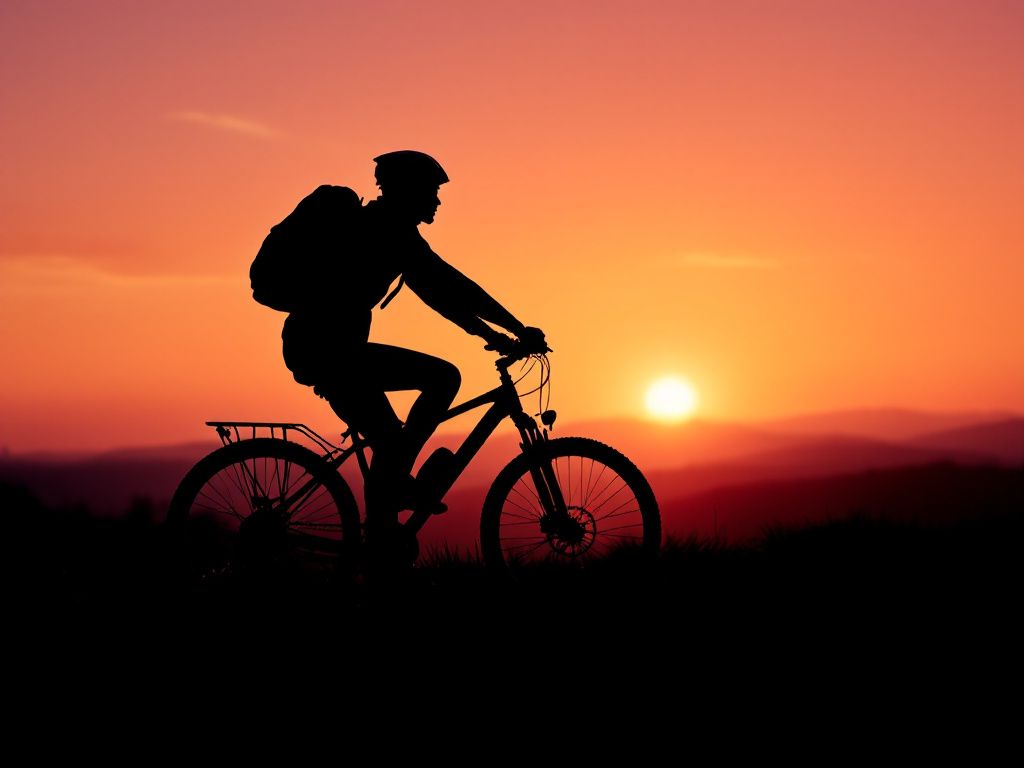Hey there, fellow cyclist! Raise your hand if you’ve ever returned from a thrilling ride only to find your skin throwing a tantrum? Yep, we’re talking about sports acne. It’s one of those annoying and all-too-common issues that loves to tag along on your biking adventures. I mean, you’re out there cycling for the thrill, the freedom, and those stellar views, not for skincare nightmares. So, what gives? Why can’t your skin just cooperate? Let’s dive into that!
What’s Up with Sports Acne on Your Cycling Adventures?
You’d think mountain biking or road cycling would be all about toned muscles and the wind in your hair, but nope, somehow sports acne squeezes its way into the picture. Cycling in particular can be rough on your skin. Long hours in the saddle mean sweating—a lot. Combine that with protective gear trapping heat and moisture, and you’ve got a prime recipe for those unwanted breakouts.
Add to that the friction caused by helmets and pads, mixed with grimy air pollution as you pedal through the city or countryside, and, well, it’s no surprise your skin starts to revolt. And let’s be honest, it’s a bit of a mood killer when you’re just trying to ride the day away.
Why Cycling Makes Sports Acne a Deal
So, let’s break it down. Cycling causes a constant flow of sweat that mixes with bacteria and oil on your skin. Voila, clogged pores. Those sleek shorts and fitted jerseys? They trap grease like nobody’s business, making things worse. Oh, and did I mention wind protection gear like scarves and balaclavas? Yep, they add to this tricky dance by shielding us from chilly winds but occasionally contribute to blocked pores too.
You’re probably thinking—cut the clothes and feel free, right? Well, it’s not that simple. Good gear is essential for safety and performance, and ditches don’t grow soft playgrounds. So, how do we find balance? Spoiler alert: it’s all about creating a sustainable skincare routine.
Pre-Ride Skin Prep: Gear Up Before You Get Those Pedals Spinning
Before hopping on your bike, take a moment to set your skin up for success. Think of it as slipping into a comfy riding rhythm—prepare well, and everything just flows. Start by cleansing your skin with a gentle, non-drying cleanser. Something mild works best. You’re not looking to strip your skin of its natural oils but rather create a fresh canvas.

Once that’s done, apply a lightweight moisturizer that’s non-comedogenic to provide your skin with a breathable barrier. If you’re planning a long ride, slather on some sunscreen afterward. Think of it as wearing your helmet—not negotiable. Get a formulation either designed for sports or a simple mineral-based one that won’t cause residue-related drama.
Key Tip: Gear Check for Your Skin
Now, about sports gear: adjust everything to minimize skin friction. Ensure your helmet, pads, and jersey fit snugly without pinching or rubbing. And if you’re sporting layers for wind protection, think breathable fabrics. Sometimes, an easy switch from synthetic fabrics to moisture-wicking materials can work wonders. Trust me on this one.
During-the-Ride Skin Care: Mid-Ride Touch-Ups
Okay, so you’re on the move and already killing it. But your skincare regimen doesn’t have to get left in the back seat. Heat and sweat are in full gear now. Is your face just itching to shed that perspiration with a swift arm rub? Easy there, tiger. Resist the urge; rubbing just spreads oils across your skin. Instead, pack an antimicrobial glove liner or hand towel—something to wick away that sweat without pushing it deeper into your pores.
Another little trick is to keep travel-sized face wipes on hand. Mid-ride, they refresh like crazy and don’t live unforgivably in your jersey pocket. Light refreshing face-mists can also be your undercover allies here, especially keeping in mind those hot afternoon rides. A gentle spritz cools down the skin, offering that just-in-time clutch moment.
Post-Ride Clean-Up: Kick Back, Then Clean Up
Ah, the post-ride glow, aka grit and accomplishment. After hitting the trail or roads, don’t chill too long in sweaty clothes. As tempting as grabbing a post-ride snack is, unwind first by dealing with your skin. Quick showers are near-magical once you start loving that lukewarm water washdown—it’s real effective in flushing the grime without pulling a ‘skin-demanding-oil’ joke.
Breakdown of the Shower Process:
- Rinse First: Start with plain water, rinsing off the first layer of sweat.
- Use Gentle Cleansers: Go for a non-stripping body wash, primarily on friction-prone areas.
- Tackle Your Hair: Whether long or short, skipping the shampoo will keep oils in your layer game.
- Condition Like a Pro: Drive that hydration post-wash in your routine by conditioning.
Taking that bit of time helps reduce buildup, and your skin’s bound to thank you.

Dry Off Carefully
Pat your skin—do not rub. It prevents all that unnecessary irritation that makes bumps swell up like they’re in a contest. Follow up with a soothing moisturizer. One infused with ingredients like aloe or chamomile works great on calming exercise-induced inflammation. You’re not over here competing with moisturizers. Light and effective is precisely where it’s at.
Don’t Forget Your Daily Routine
On non-cycling days, maintain your regular skincare as a reinforcement campaign. Your skin needs a break, so provide those days by using hydration-rich. Add into your daily routine a high-factor sunscreen used even on colder, overcast riding days—it’s that level of importance.
The Gear Debate: Swaps & Smarter Choices
Now for some gear-centric wizardry. Yes, those clothing swaps mentioned before—opt for breathable, temperature-regulating clothes. Think merino wool blends or synthetics that can play team weather nicely. It’s essential in the war on sports acne, reducing heat buildup, and limiting sweaty seals formed by cheaper fabrics.
Additionally, make adjustable gear your best friend. Adjustability and functionality in gear allow venting away moisture. Those airflow helmet features? They tick safety and sweat-evaporation boxes.
Sports Gear Smarter Choices:
- Breathable Helmets: Adequate ventilation to maintain skin circulation.
- Wicking Fabrics: Redirect sweat away effectively to keep you dry.
- Smart Gloves: Opt for antimicrobial treatments embedded to ease bacteria brawls.
Extending Your Skincare Inventory
Let’s tangent a bit and chat hero products—it never hurts to invest in skincare allies that have your track saddle too.

**Salicylic Acid Lotions:** These help clear up acne by unblocking clogged pores without the harshness. Easy integration, with dual use on or off the saddle.
**Hydrating Mists:** Include face mists Tor hydration boosts between miles. Ideal on-the-go riding because you directly refresh the face’s vulnerable barrier.
**Aloe Vera Gel:** On some days, soothing gels under harsh sun-replays aid cooling and antibacterial swabs.
Cycling skin stories don’t have to ride solo. Integrating targeted products further armor your fight against sports acne without excessive weighing-down fear.
Reinforcing Routine: Reflect & Adjust
Reinforcing your routine means minds’ constant checks. Sometimes, what cycles all right one season loses influences completely during weathers shift. Take a pause and deliberate—parts of your regimen take effect better under cooler breezes while slip masking during relentless muggy stretches.
Reevaluating Through Changing Seasons
- Winter Shielding: Increase moisture with thicker creams, compensating dry winter air.
- Summertime Lightweights: Favor lighter serums and gels to advantage layer abilities with turning heat fonts.
Riding Skin-Game Readiness is Achievable!
Ready to harmonize your cycling passions with skin tranquility? Embrace these outlines along-side roadways. Because operating them isn’t about fancy, deep layers of routines stacking unnecessarily. Instead, build coherently through trials and reliable aids assuaged for inept upheavals sports pursuits distribute.
Wrapping up this a little tidbit-chat, hedge fun roads whirling passionate spins by tuning your routine confidently. Let routines reflect simple joys practiced without expanding rebel bumps triggers with concentrated direction.
Frequently Asked Questions
What is sports acne?
Sports acne, also known as acne mechanica, is a type of acne that occurs due to the friction and heat trapped by sports equipment or clothing. This friction and heat can irritate the skin, leading to acne breakouts, especially in areas where the equipment rubs against the skin[1][5][4].
How can I prevent sports acne?
To prevent sports acne, it is recommended to place clean, soft padding between the equipment and your skin to reduce friction. Wearing moisture-wicking clothes and loose-fitting workout clothes can also help by keeping sweat away from the skin. Additionally, practicing good post-workout hygiene, such as showering immediately after exercising and using cleansers with benzoyl peroxide or salicylic acid, can help prevent acne breakouts[1][2][3].
What are some common areas affected by sports acne?
Sports acne can affect various areas depending on the type of sports equipment used. For example, football and hockey players may experience acne on their chin, shoulders, or forehead due to helmets and protective gear. Shot-putters may develop acne on their necks, and cyclists may experience it on their forehead due to their helmets. Other areas can include the back and shoulders from backpacks or synthetic dance clothes[1][5][4].
How can I treat sports acne if it occurs?
If sports acne occurs, it can be treated with acne medications containing salicylic acid, which helps unclog pores. Using benzoyl peroxide cleansers or wipes can also help by killing acne-causing bacteria and reducing inflammation. For persistent cases, consulting a dermatologist for personalized treatment options, such as topical medications or oral antibiotics, may be necessary[2][3][4].
References- Is sports equipment causing your acne?. American Academy of Dermatology.
- Tackling Sports-Related Acne: Strategies for Treatment and Prevention. Annapolis Moms Media.
- Is your workout causing your acne?. American Academy of Dermatology.
- Sports season and body acne: 4 tips to bench this teen health issue. Marshfield Clinic Health System.
- Causes and Treatment for Body Acne. WebMD.











